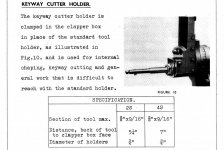Hi guys, I bought a nice Alba 1A Shaper a few month ago. It's in good condition and a very nice machine to work with.
Video of my Alba 1A Shaper:
YouTube
I needed to cut a keyway and made a cutting tool for this.
Video of the tool:
YouTube
I had some trouble getting enough pressure on the tool but I don't exactly understand why. Maybe you guys have any idea?
I used the tool in the clapper box. The tool was ground to 2 degree of clearance (side and front) and 10 degree on the cutting angle. I didn't cut until I gave it some down pressure with a bicycle inner tube. With that it worked great.
I know there are many people using a fixed tool holder and not the clapper box. But the manual showed a keyway cutting tool that was mounted in the clapper box. Was my tool to long? Do I need to have a fixed mounting? Why? Someone suggested grinding 4-degree angle on the front of the cutter to pull it more down. Where my tool angels not correct?
Looking forward to hear some suggestions.
Greetings from the Netherlands, Bart
Video of my Alba 1A Shaper:
YouTube
I needed to cut a keyway and made a cutting tool for this.
Video of the tool:
YouTube
I had some trouble getting enough pressure on the tool but I don't exactly understand why. Maybe you guys have any idea?
I used the tool in the clapper box. The tool was ground to 2 degree of clearance (side and front) and 10 degree on the cutting angle. I didn't cut until I gave it some down pressure with a bicycle inner tube. With that it worked great.
I know there are many people using a fixed tool holder and not the clapper box. But the manual showed a keyway cutting tool that was mounted in the clapper box. Was my tool to long? Do I need to have a fixed mounting? Why? Someone suggested grinding 4-degree angle on the front of the cutter to pull it more down. Where my tool angels not correct?
Looking forward to hear some suggestions.
Greetings from the Netherlands, Bart











